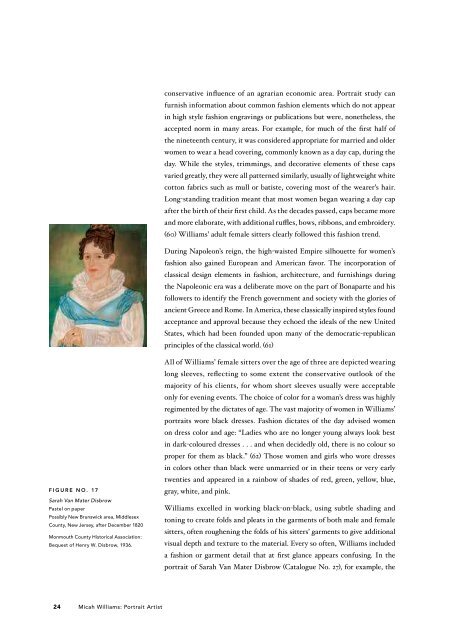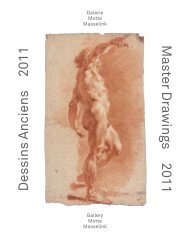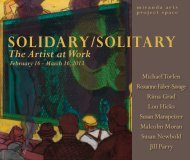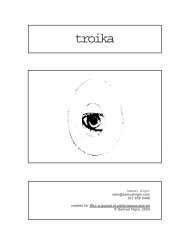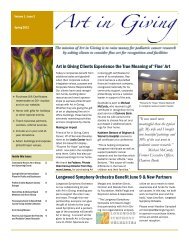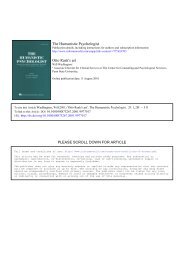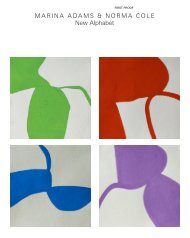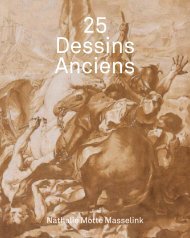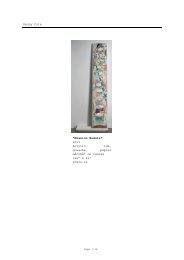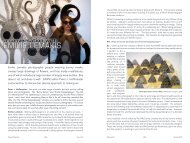Micah Williams Portrait Artist - Icompendium
Micah Williams Portrait Artist - Icompendium
Micah Williams Portrait Artist - Icompendium
You also want an ePaper? Increase the reach of your titles
YUMPU automatically turns print PDFs into web optimized ePapers that Google loves.
figure no. 17<br />
Sarah Van Mater Disbrow<br />
Pastel on paper<br />
Possibly New Brunswick area, Middlesex<br />
County, New Jersey, after December 1820<br />
Monmouth County Historical Association:<br />
Bequest of Henry W. Disbrow, 1936.<br />
conservative influence of an agrarian economic area. <strong>Portrait</strong> study can<br />
furnish information about common fashion elements which do not appear<br />
in high style fashion engravings or publications but were, nonetheless, the<br />
accepted norm in many areas. For example, for much of the first half of<br />
the nineteenth century, it was considered appropriate for married and older<br />
women to wear a head covering, commonly known as a day cap, during the<br />
day. While the styles, trimmings, and decorative elements of these caps<br />
varied greatly, they were all patterned similarly, usually of lightweight white<br />
cotton fabrics such as mull or batiste, covering most of the wearer’s hair.<br />
Long-standing tradition meant that most women began wearing a day cap<br />
after the birth of their first child. As the decades passed, caps became more<br />
and more elaborate, with additional ruffles, bows, ribbons, and embroidery.<br />
(60) <strong>Williams</strong>’ adult female sitters clearly followed this fashion trend.<br />
During Napoleon’s reign, the high-waisted Empire silhouette for women’s<br />
fashion also gained European and American favor. The incorporation of<br />
classical design elements in fashion, architecture, and furnishings during<br />
the Napoleonic era was a deliberate move on the part of Bonaparte and his<br />
followers to identify the French government and society with the glories of<br />
ancient Greece and Rome. In America, these classically inspired styles found<br />
acceptance and approval because they echoed the ideals of the new United<br />
States, which had been founded upon many of the democratic-republican<br />
principles of the classical world. (61)<br />
All of <strong>Williams</strong>’ female sitters over the age of three are depicted wearing<br />
long sleeves, reflecting to some extent the conservative outlook of the<br />
majority of his clients, for whom short sleeves usually were acceptable<br />
only for evening events. The choice of color for a woman’s dress was highly<br />
regimented by the dictates of age. The vast majority of women in <strong>Williams</strong>’<br />
portraits wore black dresses. Fashion dictates of the day advised women<br />
on dress color and age: “Ladies who are no longer young always look best<br />
in dark-coloured dresses . . . and when decidedly old, there is no colour so<br />
proper for them as black.” (62) Those women and girls who wore dresses<br />
in colors other than black were unmarried or in their teens or very early<br />
twenties and appeared in a rainbow of shades of red, green, yellow, blue,<br />
gray, white, and pink.<br />
<strong>Williams</strong> excelled in working black-on-black, using subtle shading and<br />
toning to create folds and pleats in the garments of both male and female<br />
sitters, often roughening the folds of his sitters’ garments to give additional<br />
visual depth and texture to the material. Every so often, <strong>Williams</strong> included<br />
a fashion or garment detail that at first glance appears confusing. In the<br />
portrait of Sarah Van Mater Disbrow (Catalogue No. 27), for example, the<br />
young woman appears to be sporting a stack of thin white bangle bracelets<br />
around her wrist. A study of similar garments of the time period reveals that<br />
<strong>Williams</strong> was depicting an interesting cording treatment on the wrists or<br />
cuffs of the dress, where thin cotton string or cord was tightly sewn side by<br />
side to create a charming and visually intriguing cuff detail.<br />
Nearly all of <strong>Williams</strong>’ female sitters wore some type of ruffled collar, often<br />
made by the sitter herself, an excellent way for the wearer to show off her<br />
skill with a needle and thread. Usually of fine white cotton batiste or mull,<br />
the collars were practical as well as decorative. Silk and wool dresses were<br />
not scrubbed and washed, but only spot-cleaned. Collars and matching<br />
cuffs or undersleeves protected the expensive dress fabrics from body oils<br />
and perspiration and could easily be laundered, starched, and pressed. (63)<br />
Just as society accepted and determined matters of dress, hairstyles also<br />
fell into a relatively narrow range of acceptable choices during this time<br />
period. In the majority of the artist’s portraits, his female sitters from age<br />
thirteen wore their hair similarly. The longer back hair was pulled away<br />
from the face, braided or coiled at the top of the head, and held in place by<br />
a large, curved tortoiseshell hair comb. The popularity of the large, curved<br />
tortoiseshell combs corresponded with the hairstyles of the early nineteenth<br />
century. Front hair was either smoothly looped or curled in short clusters<br />
above the ears. Smaller, flat combs were used to keep the side hair smooth<br />
and close to the scalp. Older women and married women with children who<br />
wore elaborate day caps could still wear their combs under the high-puffed<br />
crowns of their caps.<br />
The term “tortoiseshell” is misleading, as the combs were made from the<br />
shells of the hawksbill turtle, a marine turtle found in warm coastal areas.<br />
The majority of the shells and ready-made combs were imported into the<br />
United States from China and India. (64) American comb makers were able<br />
to compete with foreign comb makers, and several mechanical improvements<br />
introduced between 1817 and 1845 in the comb making process also<br />
encouraged the industry. (65)<br />
The men in <strong>Micah</strong> <strong>Williams</strong>’ portraits were highly individualistic even<br />
within the narrow confines of early nineteenth century men’s fashions.<br />
Although the men’s portraits do not contain the numerous fashionable<br />
details of caps, shawls, jewelry, and other accessories, <strong>Micah</strong> <strong>Williams</strong> was<br />
certainly able to capture the personalities of his male sitters effectively.<br />
Men’s coats appeared in only a few colors, black being the most common.<br />
Some men wore medium or dark blue coats, while several portraits included<br />
a vivid, bright blue as a coat color choice. Brown also appears to have been<br />
worn. The coats would have been made of wool, possibly broadcloth, for<br />
figure no. 18<br />
Tortoiseshell combs were a popular<br />
and useful fashion accessory for<br />
women. Here, two combs dating<br />
from 1810 to 1830, worn by Monmouth<br />
County residents.<br />
Collection Monmouth County<br />
Historical Association<br />
24 <strong>Micah</strong> <strong>Williams</strong>: <strong>Portrait</strong> <strong>Artist</strong> <strong>Micah</strong> <strong>Williams</strong>: <strong>Portrait</strong> <strong>Artist</strong> 25


